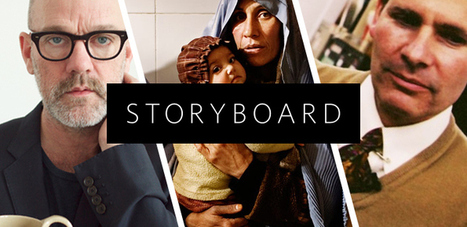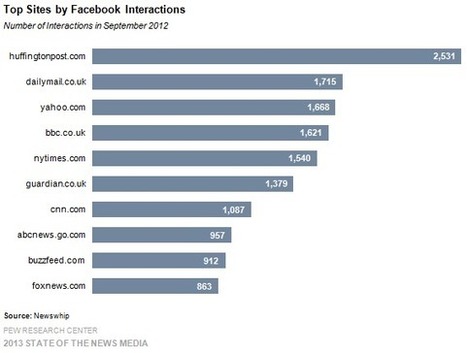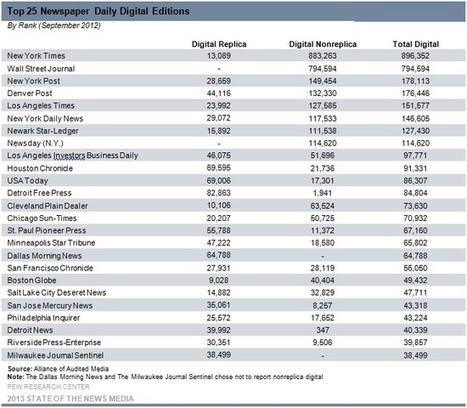 Your new post is loading...
 Your new post is loading...
As if the newspaper business didn’t have enough trouble already, the position of “newspaper reporter” has been named the single worst job in the United States – again.
The extremely dubious honor was conferred on the beleaguered industry by CareerCast, which offers job listings in local and niche job markets. While it’s probably not much comfort, a number of other traditional media careers are also in the doghouse.
According to CareerCast’s list of the 400 best and worst jobs, newspaper reporter came in at the very bottom with a median salary of $37,200 for a print reporter, plus a negative growth outlook for the industry of -9%....
The media industry may be hurting, but journalism -- and access to information -- is flourishing. Journalists may just have to work smarter, and network more, to keep up.... Journalism is not in crisis. The media industry — and journalists — might be, but the journalism itself is actually improving. Such is the argument made by international documentary filmmaker Bregtje van der Haak and Annenberg professors Michael Parks and Manuel Castells in a recently published article about “Networked Journalism.” As the authors see it, the problem is that most of the doomsayers mix the concept of journalism with the business of journalism. In their article, journalism is defined as the “production of reliable information and analysis needed for the adequate performance of a democratic society.” Not mentioned in the definition are “profits,” “professional journalists” or “traditional publishers.” Just the pursuit of reliable information....
Guardian digital development editor Joanna Geary answers some questions about GuardianWitness.... ...First up: this was built in two months. The sponsorship pot from EE gave them a budget and time to get the job done, but not necessarily have everything they wanted at launch. She says it's a complete, working system that can be built upon. I suggest the phrase "minimum viable product" to Jo but she suggests that it's a full product - one that will be built on. Do they have aspirations for more integration with social media? Yes, they do. And it's something they're looking at as the system develops. The key part of the development which is invisible to us right now is that the Guardian Witness system is deeply integrated with the Guardian's CMS. Once the content has passed through verification, it's available to the journalists, and they can insert it into a story or liveblog just by inserting an URL, which creates an embedded version of the contribution that links back to the contributor's profile. "The really exciting thing is not what you see now, but what you see when Witness is included in a story," she says. It's a tool to facilitate genuine collaborative working between the journalist and external witnesses. Jo says they'll collaborate with people on the ground, or with expert knowledge, in any way they can - and already do, via phone and other traditional methods. This adds another tool for doing that....
...At their core, Facebook, Tumblr, and Twitter are sharing networks, not publishing companies. They act as platforms for other people’s content, which can be spread rapidly and massively among their communities. A consequence of being walled gardens that restricts this sharing activity within their own properties, however, is that they give up the right to decide when and how that content breaks free into the wider public discourse. Even though it had success with its partnerships program at placing stories into other forums, Storyboard’s stories always had the whiff of marketing, or what is these days being described as “native advertising.” As we now know, that ultimately did not work out for Tumblr. Going by Fletcher’s comments, perhaps Facebook Stories will meet a similar fate....
When Facebook introduced its redesigned News Feed, it did more than change how people view memes and photos of cats — it altered the way stories are seen. Now everyone can make news. But for those who make a living by spreading news, Facebook has changed the way stories are presented. Dean Praetorius, a senior editor with The Huffington Post, talked with AllFacebook about how the way news is presented on Facebook requires some changes to the traditional approach. The Huffington Post has recently been lauded for its popularity on Facebook. Pew Research Center presented findings regarding news and social media, citing a study by Newswhip showing that the online newspaper was by far the most engaged news source on Facebook. In terms of Facebook interactions, HuffPost beat out more traditional companies, such as The Daily Mail, The New York Times, and CNN. How did HuffPost accomplish this? Praetorius said that the company has taken a well-rounded approach to social media, knowing that the story is far from completed when it’s published. HuffPost also thinks about stories differently from print media outlets and TV stations. Praetorius said that stories on the site are meant to generate conversation, and not so much to simply inform, as an old-school newspaper would...
|
Evan Williams sees Medium, the blogging platform that he and Biz Stone launched last year, as a modern-day magazine. When Twitter cofounders Evan Williams and Biz Stone launched Medium last year, their goal was for it to be a collaborative publishing tool that connected writers to a larger network. But that vision also hinges on quality, curation and, in some ways, a higher barrier to entry than platforms like Twitter. “We’re going to be a great place for professional writers to write,” Williams told Wired senior writer Steven Levy at the Wired Business Conference in New York on Tuesday. “The magazine is the analog for what we’re doing.”
Traditional news organizations need to embrace the disruption brought by digital culture -- or they risk becoming obsolete. That was the message late last week at the International Symposium on Online Journalism hosted by the Knight Center for Journalism in the Americas at the University of Texas at Austin, where about 370 of the world's journalists, researchers and media watchers grappled with the hard questions for a beleaguered traditional media industry that is now more than a decade into its disruptive transformation. The problem is many media companies view digital technologies through a lens of traditional journalism and thus, fail to strategize properly, said Clark Gilbert, president and CEO of Deseret News Publishing Company. "In a post-disruption world, why would people pick up a paper at all? Why would someone turn on the 10 o'clock newscast?" Gilbert asked. "If you are not asking those fundamental questions, there is not a future for you legacy organization." The key to surviving? Innovate. Fail. Innovate again....
Terrible events such as yesterday’s bombings at the Boston Marathon have always meant “all hands on deck” for news organizations, with staffers pulled off their regular beats to contribute. But the endpoint of the newsgathering and reporting is no longer a front-page package of stories explaining — the best one can — what happened, why it happened and what might be next. Now, there is no endpoint — events are reported in real time, with stories in constant motion, and the front page is a snapshot of an organization’s reporting at the moment when the presses needed to roll. Boston was a reminder of that, and a look at what’s changing in real-time journalism. Through Twitter and various live blogs, I found myself looking over my shoulder at the Boston Globe, the New York Times, Reuters and other news organizations, and was able to make some observations and draw some conclusions....
Don't be fooled by evangelists of 'free': editorial ethics and real reporting have been blown up along with the business model. Over at Slate the other day, Matthew Yglesias argued that journalism consumers are enjoying a "golden age". Yeah, sort of – in exactly the way looters enjoy an improved standard of living. Problem is, it only stays improved until the store is emptied out.
The news industry has gone from being obscenely profitable to slightly profitable to – at least, in the case of newspapers – largely unprofitable. All of that fantastic content Yglesias was gushing about is paid for by venture capitalists making bad bets, established media companies digging into their savings accounts to pay the bills, displaced workers earning peanuts, amateurs, semi-pros, volunteers and monks.
I would say that the business model is unsustainable, but losing money is not a business model. It is a going-out-of-business model....
If the newspaper industry had theme music in 2013, it might use “Been down so long it looks like up to me,” the much-recycled line from a 1920s blues song. For the first time since the deep recession that began in 2007, newspaper organizations have grounds for a modicum of optimism... Companies have started to experiment in a big way with a variety of new revenue streams and major organizational changes. Some of the bright opportunities – such as offering social marketing services to local businesses – are ventures too new to be measured yet industry-wide. They show signs of stabilizing revenue.... Even halting improvement in the general economy helps the industry. The double whammy of cyclical ad losses on top of secular shift to new media has considerably eased from the worst of the recession from 2007 to 2010. Auto advertising has come back, and some markets, like Miami, are beginning to see recovery in real estate and employment ads as well. All those positives, however, are for the time being mostly promise rather than performance. The most basic indicators have not turned around. The industry is little more than half the size it once was. Considerable dangers persist... So the industry entered 2013 with some positive signs but still dealing with difficult economic realities. The two biggest newspaper developments of the last year – digital paywalls and reduced print frequency – capture that odd mix of expansion and contraction now typical within the industry....
|
 Your new post is loading...
Your new post is loading...
 Your new post is loading...
Your new post is loading...



















Not a surprise, but if I was a reporter I would look at reinventing, retraining and repositioning into social media or PR where salaries are more substantial.